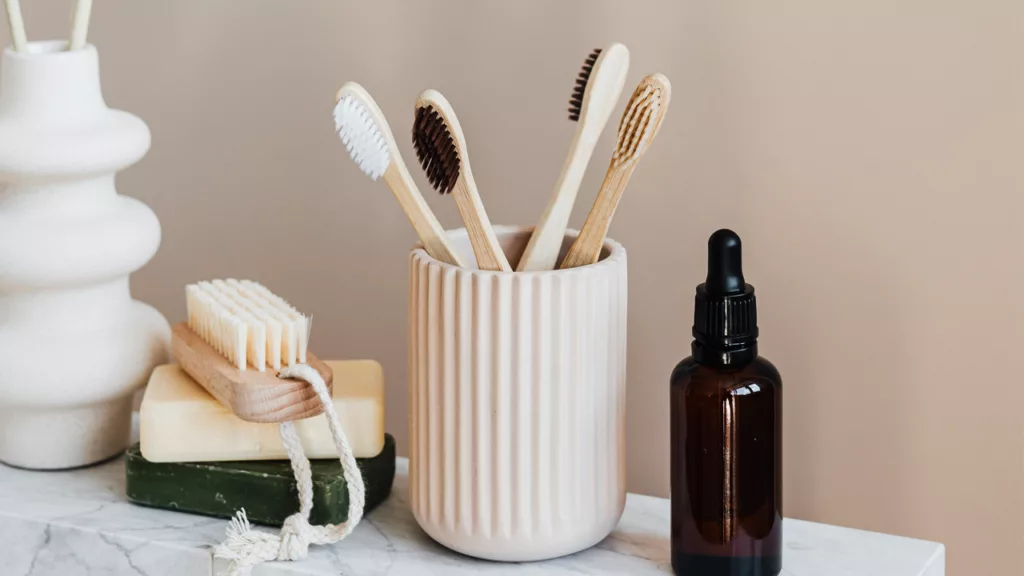Vegan Food & Lifestyle Blog, Vegan Lifestyle
Cruelty-Free Beauty: A Vegan Guide to Cosmetics and Personal Care Products
As a vegan, you may be concerned about the animal testing that goes into many cosmetics and personal care products. Luckily, there are now many cruelty-free options available that allow you to indulge in beauty products without compromising your values. Here’s a vegan guide to cruelty-free cosmetics and personal care products.
Common Non-Vegan Ingredients to Watch Out For in Cosmetics and Personal Care Products
Here are some common non-vegan ingredients to watch out for in cosmetics and personal care products:
| Ingredient | What it is | Used for | Non-Vegan Source |
|---|---|---|---|
| Beeswax | A wax produced by bees | Used as an emulsifying agent, a thickening agent, and as a fragrance ingredient | Obtained from bees |
| Carmine | A red pigment derived from cochineal beetles | Used as a colorant in cosmetics, food and beverages | Obtained from crushed cochineal beetles |
| Collagen | A protein found in animal connective tissues | Used as a moisturizing and firming agent in skin care products | Derived from animal bones, skin, and connective tissues |
| Gelatin | A protein obtained by boiling skin, tendons, ligaments and bones | Used as a thickener in cosmetic and personal care products | Derived from animal bones and connective tissues |
| Hyaluronic Acid | A molecule found in animal connective tissues and skin | Used as a moisturizing agent in skin care products | Derived from animal sources such as rooster combs and fetal calf skin |
| Lanolin | A greasy substance obtained from the sebaceous glands of sheep | Used as an emollient and moisturizing ingredient in skin care and cosmetic products | Obtained from sheep wool |
| Pearl Powder | A fine powder made from freshwater or saltwater pearls | Used as a cosmetic ingredient for skin lightening and as an exfoliant | Obtained from mollusk shells |
| Propolis | A sticky resin produced by bees | Used as an antiseptic and anti-inflammatory ingredient in skin care products | Obtained from bees |
| Royal Jelly | A milky secretion produced by honey bees | Used as a moisturizing and anti-aging ingredient in skin care products | Obtained from honey bees |
| Squalene | An oil produced by shark liver | Used as a moisturizing ingredient in skin care products | Obtained from shark liver |
Cruelty-Free vs Vegan: Understanding the Differences in Cosmetics and Personal Care Products
Vegan and cruelty-free beauty are two terms often used in the cosmetics industry, but they have different meanings.
Cruelty-free beauty refers to products that are not tested on animals. It means that the product, as well as its ingredients, have not been tested on animals at any point during production. This term is not regulated, so companies can make their own claims about being cruelty-free.
Vegan, on the other hand, refers to products that do not contain any animal-derived ingredients. Cosmetics that are vegan do not use ingredients like beeswax, collagen, gelatin, and honey. Vegan cosmetics can also be cruelty-free, but not all cruelty-free products are vegan.
In summary, cruelty-free refers to the testing process, while vegan refers to the ingredients used in the product.
Look for the Leaping Bunny or PETA’s Beauty Without Bunnies logos
The Leaping Bunny and PETA’s Beauty Without Bunnies logos are two of the most widely recognized certifications for cruelty-free products. These logos indicate that a brand does not conduct, commission, or pay for any tests on animals.
PETA’s Beauty Without Bunnies program has a set of criteria that cosmetics, personal care, and household cleaning products must meet in order to be eligible for the program. The main criteria are:
- The product must not test the product or any of its ingredients on animals at any point during the development process
- The company must not commission or pay for any animal tests conducted by others.
- The company must not sell its products in China or any other country that requires animal testing by law.
In addition to these main criteria, PETA also expects companies to have a statement on their website outlining their animal testing policy, to provide documentation to verify their animal testing policy and to sign PETA’s statement of assurance.
If a company meets these criteria, they can use the PETA’s Beauty Without Bunnies logo on its packaging and marketing materials to indicate that its products are cruelty-free.

Check the ingredient list
Some ingredients, such as honey, beeswax, and carmine (a red pigment made from crushed insects), are not vegan. If you see any of these ingredients on the label, it’s a good indication that the product is not vegan and not a cruelty-free beauty product.
Check the company’s animal testing policy
Many companies have a statement on their website about their animal testing policy. Look for phrases like “cruelty-free,” “not tested on animals,” or “vegan.” If you can’t find this information on the company’s website, try contacting them directly to ask about their animal testing practices.
Shop at cruelty-free stores or online retailers
There are now many stores and online retailers that specialize in cruelty-free products. These retailers make it easy to find vegan, cruelty-free options all in one place.
Don’t forget about personal care products
It’s not just cosmetics that may be tested on animals. Many companies test cosmetics, toothpaste, soap, and deodorant on animals. Be sure to check the labels on these products as well to ensure that they are cruelty-free.
Know the limitations of cruelty-free certifications
While the Leaping Bunny and PETA’s Beauty Without Bunnies logos are reliable indicators of a brand’s animal testing practices, they do have limitations. For example, these certifications only apply to the finished product and do not take into account the ingredients or manufacturing process.
Consider supporting cruelty-free beauty companies
By supporting cruelty-free beauty companies, you can help create demand for more humane products and encourage other companies to follow suit. Look for brands that are transparent about their animal testing policies and consider supporting them with your purchases.
Cruelty-free beauty is easier to find than ever before. With a little bit of research and some strategic shopping, you can indulge in cosmetics and personal care products without compromising your values.
Conclusion: Cruelty-Free Beauty
In conclusion, cruelty-free beauty is an important issue that consumers should consider when purchasing beauty products. By choosing cruelty-free products, you are not only making a statement against animal testing. But you are also supporting companies that prioritize ethical practices. With the wide range of options available in the market today. It has never been easier to find cruelty-free products that meet your needs.
From skincare to makeup, there are plenty of brands that prioritize the welfare of animals and the environment. By making a conscious effort to buy cruelty-free products, we can collectively make a difference and pave the way for a kinder and more compassionate future. As a makeup aficionado or skincare devotee, it’s crucial to transition to using cruelty-free beauty products. Consequently, the next time you shop, examine the items carefully and select one that embodies your beliefs. Keep in mind that your buying decision holds immense power to bring about change, so exercise it wisely.
Sources For Cruelty-Free Beauty Products
- PETA’s Guide to Cruelty-Free Cosmetics and Personal Care Products
- The Vegan Society’s Guide to Cruelty-Free Cosmetics
- The Environmental Working Group’s Skin Deep Cosmetics Database.




